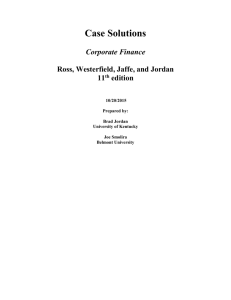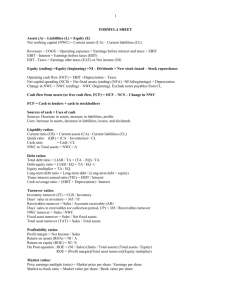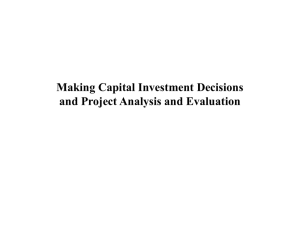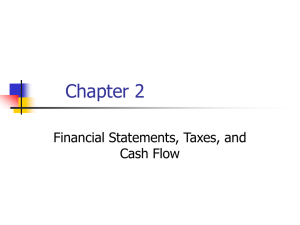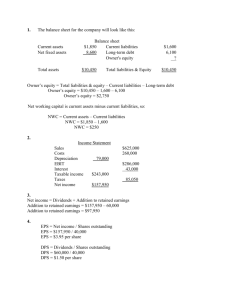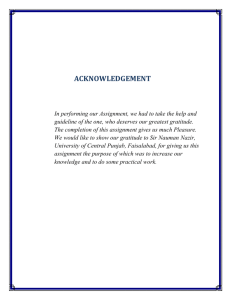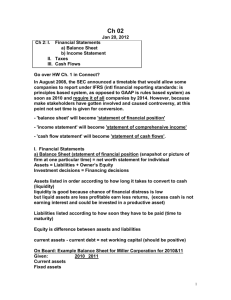Balance Sheet
advertisement
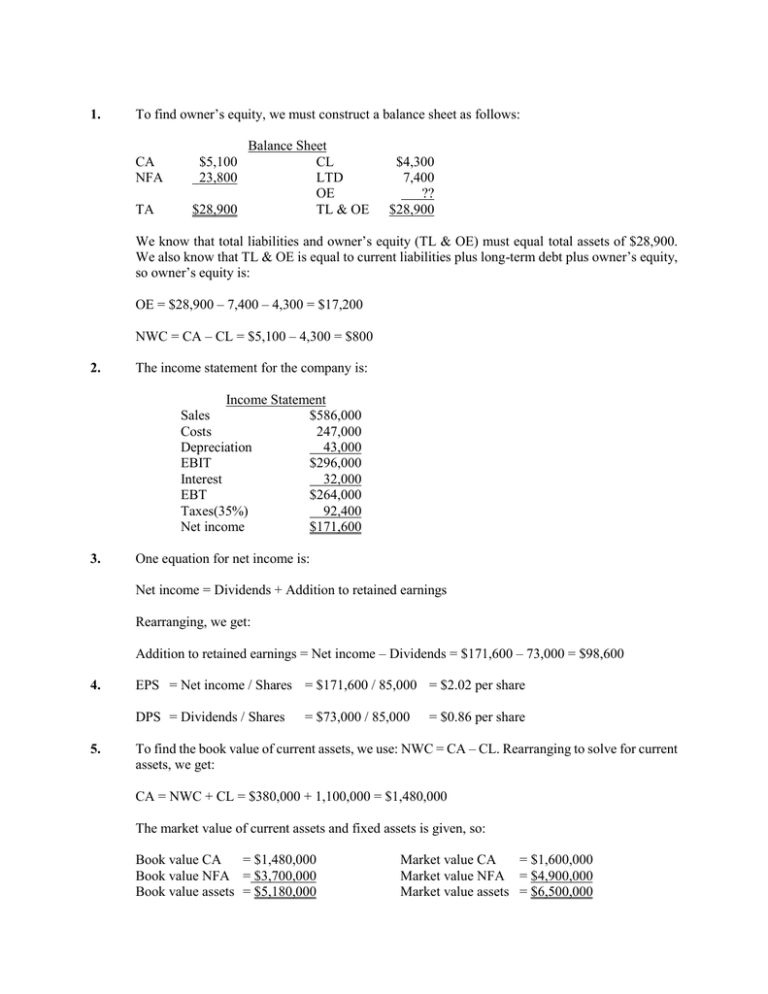
1. To find owner’s equity, we must construct a balance sheet as follows: CA NFA TA Balance Sheet $5,100 CL 23,800 LTD OE $28,900 TL & OE $4,300 7,400 ?? $28,900 We know that total liabilities and owner’s equity (TL & OE) must equal total assets of $28,900. We also know that TL & OE is equal to current liabilities plus long-term debt plus owner’s equity, so owner’s equity is: OE = $28,900 – 7,400 – 4,300 = $17,200 NWC = CA – CL = $5,100 – 4,300 = $800 2. The income statement for the company is: Income Statement Sales $586,000 Costs 247,000 Depreciation 43,000 EBIT $296,000 Interest 32,000 EBT $264,000 Taxes(35%) 92,400 Net income $171,600 3. One equation for net income is: Net income = Dividends + Addition to retained earnings Rearranging, we get: Addition to retained earnings = Net income – Dividends = $171,600 – 73,000 = $98,600 4. EPS = Net income / Shares = $171,600 / 85,000 = $2.02 per share DPS = Dividends / Shares 5. = $73,000 / 85,000 = $0.86 per share To find the book value of current assets, we use: NWC = CA – CL. Rearranging to solve for current assets, we get: CA = NWC + CL = $380,000 + 1,100,000 = $1,480,000 The market value of current assets and fixed assets is given, so: Book value CA = $1,480,000 Book value NFA = $3,700,000 Book value assets = $5,180,000 Market value CA = $1,600,000 Market value NFA = $4,900,000 Market value assets = $6,500,000 6. Taxes = 0.15($50K) + 0.25($25K) + 0.34($25K) + 0.39($236K – 100K) = $75,290 7. The average tax rate is the total tax paid divided by net income, so: Average tax rate = $75,290 / $236,000 = 31.90% The marginal tax rate is the tax rate on the next $1 of earnings, so the marginal tax rate = 39%. 8. To calculate OCF, we first need the income statement: Income Statement Sales Costs Depreciation EBIT Interest Taxable income Taxes (35%) Net income $27,500 13,280 2,300 $11,920 1,105 $10,815 3,785 $ 7,030 OCF = EBIT + Depreciation – Taxes = $11,920 + 2,300 – 3,785 = $10,435 9. Net capital spending = NFAend – NFAbeg + Depreciation Net capital spending = $4,200,000 – 3,400,000 + 385,000 Net capital spending = $1,185,000 10. Change in NWC = NWCend – NWCbeg Change in NWC = (CAend – CLend) – (CAbeg – CLbeg) Change in NWC = ($2,250 – 1,710) – ($2,100 – 1,380) Change in NWC = $540 – 720 = –$180 11. Cash flow to creditors = Interest paid – Net new borrowing Cash flow to creditors = Interest paid – (LTDend – LTDbeg) Cash flow to creditors = $170,000 – ($2,900,000 – 2,600,000) Cash flow to creditors = –$130,000 12. Cash flow to stockholders = Dividends paid – Net new equity Cash flow to stockholders = Dividends paid – [(Commonend + APISend) – (Commonbeg + APISbeg)] Cash flow to stockholders = $490,000 – [($815,000 + 5,500,000) – ($740,000 + 5,200,000)] Cash flow to stockholders = $115,000 Note, APIS is the additional paid-in surplus. 13. Cash flow from assets = Cash flow to creditors + Cash flow to stockholders = –$130,000 + 115,000 = –$15,000 Cash flow from assets = –$15,000 = OCF – Change in NWC – Net capital spending = –$15,000 = OCF – (–$85,000) – 940,000 Operating cash flow = –$15,000 – 85,000 + 940,000 Operating cash flow 14. = $840,000 To find the OCF, we first calculate net income. Income Statement Sales $196,000 Costs 104,000 Other expenses 6,800 Depreciation 9,100 EBIT $76,100 Interest 14,800 Taxable income $61,300 Taxes 21,455 Net income $39,845 Dividends Additions to RE $10,400 $29,445 a. OCF = EBIT + Depreciation – Taxes = $76,100 + 9,100 – 21,455 = $63,745 b. CFC = Interest – Net new LTD = $14,800 – (–7,300) = $22,100 Note that the net new long-term debt is negative because the company repaid part of its longterm debt. c. CFS = Dividends – Net new equity = $10,400 – 5,700 = $4,700 d. We know that CFA = CFC + CFS, so: CFA = $22,100 + 4,700 = $26,800 CFA is also equal to OCF – Net capital spending – Change in NWC. We already know OCF. Net capital spending is equal to: Net capital spending = Increase in NFA + Depreciation = $27,000 + 9,100 = $36,100 Now we can use: CFA = OCF – Net capital spending – Change in NWC $26,800 = $63,745 – 36,100 – Change in NWC Solving for the change in NWC gives $845, meaning the company increased its NWC by $845. 15. The solution to this question works the income statement backwards. Starting at the bottom: Net income = Dividends + Addition to ret. earnings = $1,500 + 5,100 = $6,600 Now, looking at the income statement: EBT – EBT × Tax rate = Net income Recognize that EBT × Tax rate is simply the calculation for taxes. Solving this for EBT yields: EBT = NI / (1– tax rate) = $6,600 / (1 – 0.35) = $10,154 Now you can calculate: EBIT = EBT + Interest = $10,154 + 4,500 = $14,654 The last step is to use: EBIT = Sales – Costs – Depreciation $14,654 = $41,000 – 19,500 – Depreciation Solving for depreciation, we find that depreciation = $6,846 16. The balance sheet for the company looks like this: Cash Accounts receivable Inventory Current assets Tangible net fixed assets Intangible net fixed assets Total assets Balance Sheet $195,000 Accounts payable 137,000 Notes payable 264,000 Current liabilities $596,000 Long-term debt Total liabilities 2,800,000 780,000 Common stock Accumulated ret. earnings $4,176,000 Total liab. & owners’ equity $405,000 160,000 $565,000 1,195,300 $1,760,300 ?? 1,934,000 $4,176,000 Total liabilities and owners’ equity is: TL & OE = CL + LTD + Common stock + Retained earnings Solving for this equation for equity gives us: Common stock = $4,176,000 – 1,934,000 – 1,760,300 = $481,700 17. The market value of shareholders’ equity cannot be negative. A negative market value in this case would imply that the company would pay you to own the stock. The market value of shareholders’ equity can be stated as: Shareholders’ equity = Max [(TA – TL), 0]. So, if TA is $8,400, equity is equal to $1,100, and if TA is $6,700, equity is equal to $0. We should note here that the book value of shareholders’ equity can be negative. 18. a. Taxes Growth = 0.15($50,000) + 0.25($25,000) + 0.34($13,000) = $18,170 Taxes Income = 0.15($50,000) + 0.25($25,000) + 0.34($25,000) + 0.39($235,000) + 0.34($8,465,000) = $2,992,000 b. Each firm has a marginal tax rate of 34% on the next $10,000 of taxable income, despite their different average tax rates, so both firms will pay an additional $3,400 in taxes. 19. a. Income Statement Sales $730,000 COGS 580,000 A&S expenses 105,000 Depreciation 135,000 EBIT –$90,000 Interest 75,000 Taxable income –$165,000 Taxes (35%) 0 Net income –$165,000 b. OCF = EBIT + Depreciation – Taxes = –$90,000 + 135,000 – 0 = $45,000 c. Net income was negative because of the tax deductibility of depreciation and interest expense. However, the actual cash flow from operations was positive because depreciation is a non-cash expense and interest is a financing expense, not an operating expense. 20. A firm can still pay out dividends if net income is negative; it just has to be sure there is sufficient cash flow to make the dividend payments. Change in NWC = Net capital spending = Net new equity = 0. (Given) Cash flow from assets = OCF – Change in NWC – Net capital spending Cash flow from assets = $45,000 – 0 – 0 = $45,000 Cash flow to stockholders = Dividends – Net new equity = $25,000 – 0 = $25,000 Cash flow to creditors = Cash flow from assets – Cash flow to stockholders Cash flow to creditors = $45,000 – 25,000 = $20,000 Cash flow to creditors = Interest – Net new LTD Net new LTD = Interest – Cash flow to creditors = $75,000 – 20,000 = $55,000 21. a. Income Statement Sales $22,800 Cost of goods sold 16,050 Depreciation 4,050 EBIT $ 2,700 Interest 1,830 Taxable income $ 870 Taxes (34%) 296 Net income $ 574 b. OCF = EBIT + Depreciation – Taxes = $2,700 + 4,050 – 296 = $6,454 c. Change in NWC = NWCend – NWCbeg = (CAend – CLend) – (CAbeg – CLbeg) = ($5,930 – 3,150) – ($4,800 – 2,700) = $2,780 – 2,100 = $680 Net capital spending = NFAend – NFAbeg + Depreciation = $16,800 – 13,650 + 4,050 = $7,200 CFA = OCF – Change in NWC – Net capital spending = $6,454 – 680 – 7,200 = –$1,426 The cash flow from assets can be positive or negative, since it represents whether the firm raised funds or distributed funds on a net basis. In this problem, even though net income and OCF are positive, the firm invested heavily in both fixed assets and net working capital; it had to raise a net $1,426 in funds from its stockholders and creditors to make these investments. d. Cash flow to creditors Cash flow to stockholders = Interest – Net new LTD = $1,830 – 0 = $1,830 = Cash flow from assets – Cash flow to creditors = –$1,426 – 1,830 = –$3,256 We can also calculate the cash flow to stockholders as: Cash flow to stockholders = Dividends – Net new equity Solving for net new equity, we get: Net new equity = $1,300 – (–3,256) = $4,556 The firm had positive earnings in an accounting sense (NI > 0) and had positive cash flow from operations. The firm invested $680 in new net working capital and $7,200 in new fixed assets. The firm had to raise $1,426 from its stakeholders to support this new investment. It accomplished this by raising $4,556 in the form of new equity. After paying out $1,300 of this in the form of dividends to shareholders and $1,830 in the form of interest to creditors, $1,426 was left to meet the firm’s cash flow needs for investment. 22. a. Total assets 2008 = $653 + 2,691 = $3,344 Total liabilities 2008 = $261 + 1,422 = $1,683 Owners’ equity 2008 = $3,344 – 1,683 = $1,661 Total assets 2009 = $707 + 3,240 = $3,947 Total liabilities 2009 = $293 + 1,512 = $1,805 Owners’ equity 2009 = $3,947 – 1,805 = $2,142 b. NWC 2008 = CA08 – CL08 = $653 – 261 = $392 NWC 2009 = CA09 – CL09 = $707 – 293 = $414 Change in NWC = NWC09 – NWC08 = $414 – 392 = $22 c. We can calculate net capital spending as: Net capital spending = Net fixed assets 2009 – Net fixed assets 2008 + Depreciation Net capital spending = $3,240 – 2,691 + 738 = $1,287 So, the company had a net capital spending cash flow of $1,287. We also know that net capital spending is: Net capital spending = Fixed assets bought – Fixed assets sold $1,287 = $1,350 – Fixed assets sold Fixed assets sold = $1,350 – 1,287 = $63 To calculate the cash flow from assets, we must first calculate the operating cash flow. The income statement is: Income Statement Sales Costs Depreciation expense EBIT Interest expense EBT Taxes (35%) Net income $ 8,280.00 3,861.00 738 .00 $3,681.00 211 .00 $3,470.00 1,215.50 $2,256.50 So, the operating cash flow is: OCF = EBIT + Depreciation – Taxes = $3,681 + 738 – 1,214.50 = $3,204.50 And the cash flow from assets is: Cash flow from assets = OCF – Change in NWC – Net capital spending. = $3,204.50 – 22 – 1,287 = $1,895.50 d. Net new borrowing Cash flow to creditors Net new borrowing Debt retired = LTD09 – LTD08 = $1,512 – 1,422 = $90 = Interest – Net new LTD = $211 – 90 = $121 = $90 = Debt issued – Debt retired = $270 – 90 = $180 Challenge 23. Net capital spending = NFAend – NFAbeg + Depreciation = (NFAend – NFAbeg) + (Depreciation + ADbeg) – ADbeg = (NFAend – NFAbeg)+ ADend – ADbeg = (NFAend + ADend) – (NFAbeg + ADbeg) = FAend – FAbeg 24. a. The tax bubble causes average tax rates to catch up to marginal tax rates, thus eliminating the tax advantage of low marginal rates for high income corporations. b. Taxes = 0.15($50,000) + 0.25($25,000) + 0.34($25,000) + 0.39($235,000) = $113,900 Average tax rate = $113,900 / $335,000 = 34% The marginal tax rate on the next dollar of income is 34 percent. For corporate taxable income levels of $335,000 to $10 million, average tax rates are equal to marginal tax rates. Taxes = 0.34($10,000,000) + 0.35($5,000,000) + 0.38($3,333,333)= $6,416,667 Average tax rate = $6,416,667 / $18,333,334 = 35% The marginal tax rate on the next dollar of income is 35 percent. For corporate taxable income levels over $18,333,334, average tax rates are again equal to marginal tax rates. c. Taxes $68,000 X($100,000) X X = 0.34($200,000) = $68,000 = 0.15($50,000) + 0.25($25,000) + 0.34($25,000) + X($100,000); = $68,000 – 22,250 = $45,750 / $100,000 = 45.75% 25. Cash Accounts receivable Inventory Current assets Balance sheet as of Dec. 31, 2008 $3,792 Accounts payable 5,021 Notes payable 8,927 Current liabilities Net fixed assets $31,805 Total assets $49,545 Total liab. & equity Inventory Current assets $4,716 $17,740 Long-term debt Owners' equity Cash Accounts receivable $3,984 732 Balance sheet as of Dec. 31, 2009 $4,041 Accounts payable 5,892 Notes payable 9,555 Current liabilities $12,700 32,129 $49,545 $4,025 717 $4,742 $19,488 Net fixed assets $33,921 Long-term debt Owners' equity Total assets $53,409 Total liab. & equity $15,435 33,232 $53,409 26. 2008 Income Statement Sales $7,233.00 COGS 2,487.00 Other expenses 591.00 Depreciation 1,038.00 EBIT $3,117.00 Interest 485.00 EBT $2,632.00 Taxes (34%) 894.88 Net income $1,737.12 2009 Income Statement Sales $8,085.00 COGS 2,942.00 Other expenses 515.00 Depreciation 1,085.00 EBIT $3,543.00 Interest 579.00 EBT $2,964.00 Taxes (34%) 1,007.76 Net income $1,956.24 Dividends Additions to RE Dividends Additions to RE $882.00 855.12 $1,011.00 945.24 OCF = EBIT + Depreciation – Taxes = $3,543 + 1,085 – 1,007.76 = $3,620.24 Change in NWC = NWCend – NWCbeg = (CA – CL) end – (CA – CL) beg = ($19,488 – 4,742) – ($17,740 – 4,716) = $1,722 Net capital spending = NFAend – NFAbeg + Depreciation = $33,921 – 31,805 + 1,085 = $3,201 Cash flow from assets = OCF – Change in NWC – Net capital spending = $3,620.24 – 1,722 – 3,201 = –$1,302.76 Cash flow to creditors = Interest – Net new LTD Net new LTD = LTDend – LTDbeg Cash flow to creditors = $579 – ($15,435 – 12,700) = –$2,156 Net new equity = Common stockend – Common stockbeg Common stock + Retained earnings = Total owners’ equity Net new equity = (OE – RE) end – (OE – RE) beg = OEend – OEbeg + REbeg – REend REend = REbeg + Additions to RE08 Net new equity = OEend – OEbeg + REbeg – (REbeg + Additions to RE08) = OEend – OEbeg – Additions to RE Net new equity = $33,232 – 32,129 – 945.24 = $157.76 CFS CFS = Dividends – Net new equity = $1,011 – 157.76 = $853.24 As a check, cash flow from assets is –$1,302.76. CFA CFA = Cash flow from creditors + Cash flow to stockholders = –$2,156 + 853.24 = –$1,302.76
